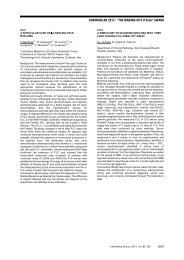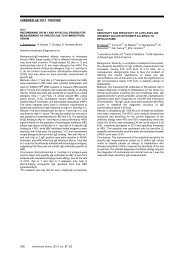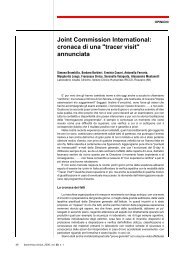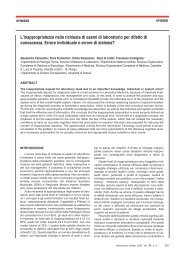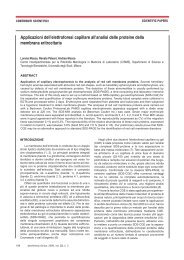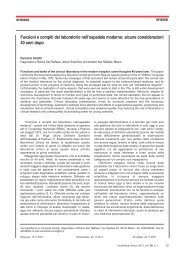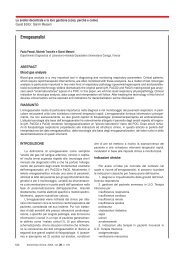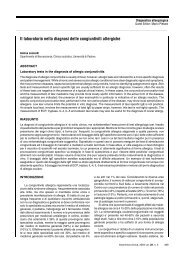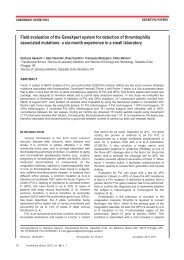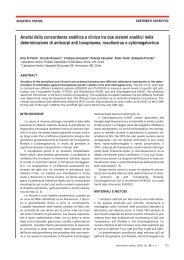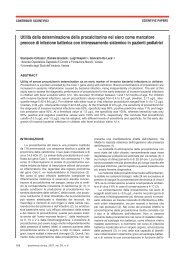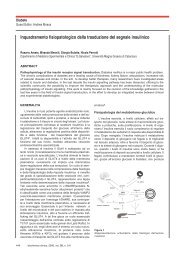Corel Ventura - ELANSARY.CHP - SIBioC
Corel Ventura - ELANSARY.CHP - SIBioC
Corel Ventura - ELANSARY.CHP - SIBioC
Create successful ePaper yourself
Turn your PDF publications into a flip-book with our unique Google optimized e-Paper software.
SCIENTIFIC PAPERS CONTRIBUTI SCIENTIFICI<br />
Evaluation of Cytokines in Pleural Fluid for the Differential Diagnosis of<br />
Tuberculous Pleurisy<br />
Amina Kamal EL-Ansary 1 , Mona Ahmed Radwan 2<br />
1 Medical Biochemistry* and Internal Medicine<br />
2 Departments, Faculty of Medicine, Cairo University<br />
ABSTRACT<br />
The present study aims to test reliability of interferon gamma (IFN- γ) as a diagnostic marker for tuberculous pleurisy.<br />
In this study, interleukin-8 (IL-8), tumour necrosis factor α (TNF-α) and interferon gamma (IFN-γ) were therefore<br />
compared with adenosine deaminase (ADA) in exudative pleural effusion of inflammatory, malignant and tuberculous<br />
origin to determine their diagnostic value and whether either or all of them could be helpful in the differential diagnosis<br />
of tuberculous pleural effusion. Subjects and methods: This study included 11 patients with inflammatory, 13 patients<br />
with malignant, and 15 patients with tuberculous effusion matched for age and sex. Estimation of Pleural fluid levels of<br />
ADA, IL-8, TNF-α and IFN-γ. Results: Pleural fluid levels of ADA, IL-8, TNF-α and IFN-γ in the tuberculous group were<br />
significantly higher than in the malignant group. Also the levels of pleural fluid ADA, TNF-α and IFN-γ in the tuberculous<br />
group were significantly higher than in the inflammatory group. Analysis of receiver operating characteristic (ROC)<br />
curves, to evaluate the utility of the various parameters, demonstrates values for the area under the curve (AUC) of<br />
0.702, 0.897, 0.927, and 0.987, respectively for IL-8, TNF α , ADA, and IFN γ. The sensitivity and specificity with IFN γ<br />
were 93% and 100%,respectively, which were superior to those for ADA(sensitivity: 80% and specificity:91%), TNF- α<br />
(sensitivity: 86% and specificity:91% ) and IL-8 (sensitivity: 46% and specificity: 72%) . Conclusions: Levels of the pleural<br />
fluid cytokines examined in this study were higher in the tuberculous than in the two other groups. Our data suggested<br />
that IFN- γ being shown to be especially very reliable, is a non -invasive and useful marker for diagnosis of tuberculous<br />
pleurisy, with clear advantages over ADA.<br />
RIASSUNTO<br />
Lo scopo di questo lavoro era di verificare la validità della misura dell’interferone gamma (IFN-γ) come un marcatore<br />
diagnostico per la pleurite tubercolare. In questo studio le concentrazioni nel liquido pleurico della interleuchina-8 (IL-8),<br />
del fattore di necrosi tumorale-α (TNF-α), e dell’ interferone-γ (FN-γ) sono state pertanto confrontate con quelle della<br />
adenosina deaminasi (ADA), in patologie infiammatoria, maligna e tubercolare, al fine di determinare il loro valore<br />
diagnostico e di verificare la loro utilità nella diagnosi differenziale di pleurite tubercolare. Lo studio includeva 11 pazienti<br />
con patologia infiammatoria, 13 pazienti con patologia maligna e 15 pazienti con pleurite tubercolare, comparabili per<br />
età e sesso. Nel liquido pleurico le concentrazioni di ADA, IL-8, TNF-α, e IFN-γ erano significativamente più elevate nel<br />
gruppo tubercolare che nel gruppo della patologia maligna. Inoltre le concentrazioni nel liquido pleurico di ADA, TNF-α<br />
e IFN-γ erano più elevate nella patologia tubercolare rispetto alla patologia infiammatoria. L’analisi delle curve "receiver<br />
operating characteristic" (ROC), ai fini di valutare l’utilità dei differenti parametri, mostrava valori dell’area sotto la curva<br />
(AUC) di: 0,702 (IL-8); 0,897 (TNF-α); 0,927 (ADA); 0,987 (IFN-γ). La sensibilità e la specificità di IFN-γ (93 % e 100 %)<br />
erano superiori a quelli di ADA (80% e 91%), di TNF-α (86 % e 91 %) e di IL-8 (46 % e 72 %). In conclusione, nel liquido<br />
pleurico le concentrazioni delle citochine esaminate in questo studio erano più alte nella tubercolosi che negli altri due<br />
gruppi. I nostri dati suggeriscono che la determinazione dell’IFN-γ appresenta un marcatore non invasivo e utile per la<br />
diagnosi di pleurite tubercolare, dimostrando chiari vantaggi nei confronti di ADA essendosi dimostrato molt valido.<br />
INTRODUCTION<br />
Tuberculosis probably stands as the most important<br />
infectious disease in humans. An estimated 1.7 billion<br />
people are infected with the Mycobacterium tuberculosis.<br />
Ten millions new cases of tuberculosis occur worldwide<br />
every year with about 3 million deaths annually. Ninety five<br />
percent (95%) of new cases of tuberculosis occur in the<br />
developing countries. In 1998, it became a social issue<br />
because an elevation in the prevalence was noted after a<br />
long period of decrease(1). Among the extrapulmonary<br />
presentations, tuberculous pleurisy is second in frequency<br />
after tuberculous lymphadenitis (29%)(2). Conventional<br />
methods for the diagnosis of tuberculous pleurisy have<br />
proven inefficient. Direct examination of pleural fluid and<br />
Ziehl-Neelsen staining requires bacillar concentrations of<br />
10,000/mL and, therefore, has a low sensitivity (0-<br />
1%)(3,4). Although a culture is more sensitive (11 to<br />
50%)(5,6), it requires 2 to 6 weeks to grow Mycobacterium<br />
tuberculosis and a minimum of 10 to 100 viable bacilli. The<br />
biochimica clinica, 2005, vol. 29, n. 1 13
CONTRIBUTI SCIENTIFICI SCIENTIFIC PAPERS<br />
sensitivity of pleural biopsy specimens is reported higher<br />
whether by culture (39 to 79%)(4,5) or histologic evaluation<br />
(71 to 80%)(3,4). However, this procedure requires<br />
greater expertise, is more invasive, and is subject to<br />
sampling error(7).<br />
Although tuberculous pleural effusion may resolve<br />
over a period of several months without treatment, a failure<br />
to diagnose and treat tuberculous pleurisy can result in<br />
progressive disease and the involvement of other organs<br />
in as many as 65% of patients(8). However, treatment<br />
based on clinical suspicion rather than on microbiological<br />
diagnosis results in overtreatment, delay in accurate diagnosis,<br />
and potentially greater morbidity(7).<br />
For daily clinical activity, however, investigation of<br />
markers in pleural fluid is far easier to perform than histological<br />
methods. Determination of adenosine deaminase<br />
(ADA) activity in pleural fluid, which is due principally to<br />
ADA2 produced by monocytes(9) and is indicative of a<br />
local, active, inflammatory response, has been in fact<br />
considered as a useful supplemental diagnostic index for<br />
tuberculous pleurisy. However, the sensitivity and specificity<br />
of this test vary from one laboratory to another with<br />
false positive and false negative results (10,11).<br />
Recently, it has been revealed that various cytokines<br />
such as interferon gamma (IFN)-γ, interleukin-8 (IL-8) and<br />
tumour necrosis factor a (TNF-α) are intimately involved<br />
in the pathognomonic physiology of tuberculosis(12). These<br />
cytokines are thought to play a role in human-cell<br />
mediated immune response to microbacterial infection.<br />
They enhance macrophage phagocytic capacity and perhaps<br />
microbacterial killing(13,14,15).<br />
In this study, IL-8, TNF-α and IFN-γ were therefore<br />
compared with ADA in exudative pleural effusion of inflammatory,<br />
malignant and tuberculous origin to determine<br />
their diagnostic value and whether either or all of them<br />
could be helpful in the differential diagnosis of tuberculous<br />
pleural effusion. The utility of each marker was evaluated<br />
by analysing its sensitivity, specificity and receiver operating<br />
characteristic (ROC) curve.<br />
SUBJECTS AND METHODS<br />
Thirty nine patients with exudative pleural effusion<br />
were diagnosed and choosen to enter this study. Patients<br />
were subjected to thorough history taking and physical<br />
examination and they underwent the following investigations:<br />
-X ray chest (posteroanterior and lateral views).<br />
-Complete blood picture and sedimentation rate. -Tuberculin<br />
test. -Sputum examination for mycobacterium tubercle<br />
bacilli by Ziehl-Neelsen stained smear . -Aspiration of<br />
pleural fluid for measurement of protein, LDH, ADA, bacteriologic<br />
examination and cytologic examination. Some of<br />
the pleural fluid was frozen to be used later on for determination<br />
of TNF- α, IL-8 and IFN- γ . Serum measurement<br />
of proteins and LDH were done at the same session of<br />
pleural fluid aspiration.<br />
Pleural fluid was designated as exudate according to<br />
Light’s criteria with LDH in pleural fluid greater than 200<br />
14 biochimica clinica, 2005, vol. 29, n. 1<br />
u/L, pleural fluid /serum LDH ratio greater than 0.6 and<br />
pleural fluid/serum protein ratio greater than 0.5(16).<br />
-Other investigations were done in some patients when<br />
needed to reach the proper diagnosis including : liver and<br />
kidney function tests , abdominal ultrasonography, computerized<br />
chest tomography, fiberoptic bronchoscopy and<br />
closed pleural biopsy.<br />
Accordingly patients were divided into three groups:<br />
Group 1: included 11 patients with inflammatory pleural<br />
effusion (parapneumonic in 8 cases and pyothorax in<br />
3 cases). They were 7 males and 4 females with mean age<br />
of 49.36 years.<br />
Group 2: included 13 patients with malignant pleural<br />
effusion (lung cancer in 10 cases and metastatic effusion<br />
in 3 cases). They were 8 males and 5 females with mean<br />
age of 52.31 years.<br />
Group 3: included 15 patients with tuberculous pleural<br />
effusion. They were 9 males and 6 females with mean age<br />
of 48.13 years.<br />
The cytokines IL-8, TNF- α and IFN- γ were estimated<br />
in the frozen pleural sample and compared between the<br />
different groups. Serum estimation of these cytokines<br />
were also done. Pleural fluid sampling: samples of pleural<br />
effusion were obtained by thoracocentesis before patients<br />
were given any treatment . After centrifugation at<br />
3000 rpm for 5 minutes , the supernatant was frozen at -<br />
80°C.<br />
Determination Of ADA: The amino radical of adenosine<br />
hydrolysed by ADA produces inosine and ammonia.<br />
When α -ketoglutaric acid and NADPH are added to the<br />
ammonia, L-glutamine and NADP+ are produced due to<br />
the reaction of glutaminic acid dehydrogenase, which reduces<br />
the NADPH. This was determined by measuring the<br />
reduction in light absorption at 340 nm to evaluate ADA.<br />
ADA activity was determined in 1ml pleural fluid using the<br />
colorimetric method described by Giusti and Galanti(17) .<br />
Determination Of Cytokines:<br />
-IL-8 concentration was estimated by an immunoenzymometric<br />
assay for the quantitative measurement of<br />
human IL-8 in biological fluids (Bio Source Europe S.A,<br />
Belgium) (18).<br />
-TNF-α concentration was estimated by an immunoenzymometric<br />
assay for the quantitative measurement of<br />
human TNF- α in biological fluids (Bio Source Europe S.A,<br />
Belgium) (19) .<br />
-IFN- γ concentration was estimated by an immunoenzymometric<br />
assay for the quantitative measurement of<br />
human IFN- γ in biological fluids (Bio Source Europe S.A,<br />
Belgium) (20) .<br />
STATISTICAL ANALYSIS<br />
The data were analysed using the Mann-Whitney method<br />
for comparison of mean ± standard error. Pearson’s<br />
correlation coefficients ’’r’’ were used to describe correlations<br />
between levels of measured parameters. ROC curve<br />
analysis was used to determine a cut-off value for making<br />
the diagnosis of tuberculosis, and the diagnostic accuracy
SCIENTIFIC PAPERS CONTRIBUTI SCIENTIFICI<br />
was evaluated by comparison of each area under the<br />
curve (AUC) (21).<br />
RESULTS<br />
Results of the study are shown in tables 1, 2 and<br />
figures (1-6)<br />
There were no difference in age and gender distribution<br />
among the different groups.<br />
The mean level of pleural fluid ADA in the tuberculous<br />
Table 1<br />
Age distribution and sex incidence<br />
Group 1<br />
(inflammatory)<br />
Group 2<br />
(Malignant)<br />
Group 3<br />
(tuberculous)<br />
Table 2<br />
Sensitivity and specificity on diagnosis of tuberculous pleural liquid<br />
IL-8<br />
(pg ml -1 )<br />
TNFα<br />
(pg ml-1)<br />
ADA<br />
(IUL -1 )<br />
group was 72.267±7.61 IU L -1 . This was significantly<br />
higher than in the other groups, with values of 36.36±6.34<br />
IU L -1 (p
CONTRIBUTI SCIENTIFICI SCIENTIFIC PAPERS<br />
spectively.<br />
The cut-off value for the cytokine was defined when<br />
the distance from the point [(1-specificity) = 0, sensitivity<br />
=1] on the ROC curve was at a minimum. For IL-8, TNF<br />
-α, ADA, IFN γ they were 875 pg ml -1 ,13 pg ml -1 , 35 IU L -1<br />
, 3.1 IU ml -1 respectively (table 2) . The sensitivity and<br />
specificity with IFN γ were 93% and 100%,respectively,<br />
which were superior to those for ADA(sensitivity: 80% and<br />
Figure 2<br />
IL-8 in pleural effusions. Mean ( ⎯ ), cut-off (-----), * p < 0.05<br />
Figure 3<br />
TNF in pleural effusions. Mean ( ⎯ ), cut-off (-----), * p < 0.05, ** p < 0.01<br />
16 biochimica clinica, 2005, vol. 29, n. 1<br />
specificity:91%), TNF- α (sensitivity: 86% and specificity:91%<br />
) and IL-8 (sensitivity: 46% and specificity: 72%)<br />
(table 2).<br />
Adenosine deaminase activity was significantly correlated<br />
with IFN-γ level(r =0.58 P
SCIENTIFIC PAPERS CONTRIBUTI SCIENTIFICI<br />
sensitivities ranging from 93% to 100%, and specificities<br />
from 76% to 100%(11). However , false-positives include<br />
cases of pyothorax and other diseases such as lung<br />
cancer, lymphoma and pleural mesothelioma. False-negatives<br />
may be either in an early stage of tuberculous<br />
pleurisy or in a state of insufficient immunity (23). The<br />
results of the present study also showed the ADA levels<br />
in the tuberculous group to be significantly higher than in<br />
the malignant and inflammatory groups. As described<br />
Figure 4<br />
IFNγ (IU ml -1 ) in pleural effusions. Mean ( ⎯ ), cut-off (-----), ** p < 0.01<br />
Figure 5<br />
ROC curves for diagnosis of tuberculosis. AUC: area under the curve. IFNγ showed a maximal<br />
area (0.987). ADA, TNFα and IL-8 recorded 0.927, 0.897 and 0.702, respectively<br />
previously , ADA seems to be a useful marker of tuberculous<br />
pleurisy.<br />
It has been reported that , in patients with tuberculous<br />
pleurisy, cell - mediated immunity participates in protection<br />
against infection with tubercle bacilli, and IL-1, -8, -10, -12,<br />
TNF- α and IFN- γ are produced (25,26).<br />
IL-8, which stimulates T cells, is known to play an<br />
important role in granulomatous process (27). Production<br />
of IL-8 by monocytes after phagocytizing tubercle bacilli<br />
has been described (28), but<br />
some researchers reported<br />
high levels in pleural fluid associated<br />
with either pyothorax<br />
or pneumonia, correlating<br />
with neutrophil counts<br />
and extent of myeloperoxidase<br />
activity (29,30). In one<br />
report IL-8 elevation was<br />
found to be greater with pyothorax<br />
or pneumonia than<br />
with tuberculosis or malignancy<br />
(31). In our study IL-<br />
8 was particularly elevated in<br />
the tuberculous group & this<br />
was significantly high when<br />
compared to the malignant<br />
group but not the inflammatory<br />
group. The reasons for<br />
the discrepancies are still<br />
unclear and may depend on<br />
the timing of specimen collection<br />
or other factors but<br />
clearly, IL-8 is not optimal as<br />
a diagnostic marker.<br />
Higher TNF- α levels in<br />
tuberculous as compared to<br />
the other groups were found<br />
in this study as in other studies<br />
(32,33). TNF- α is considered<br />
necessary for producing<br />
granulomas and removing<br />
rod-shaped bacteria<br />
in inflammatory lesions, and<br />
it is also regarded as an inducer<br />
of IFN- γ. In rheumatic<br />
pleural effusion , TNF- α increases<br />
in a similar manner<br />
as in the tuberculous case.<br />
However down-regulation of<br />
IFN- γ production occurs in<br />
rheumatic pleural liquid (34).<br />
A number of researchers<br />
have reported that distinction<br />
of tuberculous from<br />
rheumatic or inflammatory<br />
pleural effusion cannot be<br />
made with TNF- α (34).<br />
The T lymphocyte re-<br />
biochimica clinica, 2005, vol. 29, n. 1 17
CONTRIBUTI SCIENTIFICI SCIENTIFIC PAPERS<br />
sponse plays an important role in the pathogenesis of<br />
clinical manifestations and control of tuberculosis. Tuberculous<br />
pleural effusions have an increased percentage<br />
and an increased absolute number of T-lymphocytes compared<br />
with peripheral blood. Other types of effusions also<br />
have increased percentages of T-lymphocytes but the<br />
absolute number of lymphocytes is not elevated (35).<br />
Pleural infections by Mycobacterium tuberculosis are<br />
accompanied by a lymphocytic infiltrate and formation of<br />
an exudates rich in T-lymphocytes, predominantly T4<br />
lymphocytes. In vitro stimulation with purified protein derivative<br />
(PPD) leads to a proliferative response (36). Shiratsuchi<br />
and Tsuyuguchi (37) proved that PPD-induced<br />
proliferating lymphocytes mainly belonged to the T4 subset.<br />
The stimulation of T-lymphocytes also is accompanied<br />
by the production of IFN- γ (38). Some authors proved that<br />
different T-cell subsets could produce IFN- γ, with results<br />
depending on the technique, stimulus and lymphocytes<br />
used (39). Shimokata et al (40) showed that T4<br />
lymphocytes are responsible for in vitro production of IFN-γ<br />
when the tuberculous pleural lymphocytes are stimulated<br />
by PPD.<br />
The elevated IFN-γ levels found in tuberculous pleural<br />
fluids might be the equivalent in vivo of the production<br />
observed in vitro after PPD stimulation . IFN-γ detected in<br />
pleural fluid may be the result of the in situ stimulation of<br />
T4 lymphocytes by tuberculous antigens. IFN-γ is known<br />
to activate macrophages, increasing their bactericidal capacity<br />
against Mycobacterium tuberculosis (41), and when<br />
they are treated with CD4 monoclonal antibodies and<br />
complement, IFN-γ levels decreases (34). Thus the reason<br />
for the increase is considered to be production by CD4+<br />
lymphocytes reacting against tubercle bacilli . In fact , the<br />
concentration of tubercle bacilli in pleural liquid correlates<br />
with the amount of IFN-γ (34). A number of reports have<br />
demonstrated that IFN-γ levels in patients with tuberculous<br />
pleurisy are high, with sensitivities and specificities ran-<br />
Figure 6<br />
Correlation between ADA and IFN-gamma levels in tuberculous pleural effusion<br />
18 biochimica clinica, 2005, vol. 29, n. 1<br />
ging from 90% to 100% (34,42:47). Valdes et al. (11)<br />
conducted research on pleural fluid samples obtained from<br />
145 patients and reported two with small volumes out of<br />
35 tuberculous cases to be false-negative, while nine out<br />
of 110 non-tuberculous cases were false-positives ( one ;<br />
parapneumonic pleural effusion, three; pulmonary embolism,<br />
three; lymphoma, one; lymphocytic leukemia, one;<br />
neuroblastoma) (28). In our study there were no false-positives<br />
with the use of IFN- γ, and only one case with a<br />
small volume of pleural fluid presented as a false-negative.<br />
These findings provide strong support for the conclusion<br />
that IFN-γ is a reliable marker of tuberculous pleurisy.<br />
Our finding of high levels of these cytokines in tuberculous<br />
pleural effusion together with the finding of very low<br />
levels in the serum , may support the suggestion that these<br />
cytokines are produced locally by inflammatory<br />
cells(12,28,41) .<br />
ROC curves can profile sensitivity and specificity of<br />
markers, and are regarded as useful for analyzing and/or<br />
comparing diagnostic accuracy (48) . While ADA was here<br />
found to have good values for both parameters , IFN-γ was<br />
superior as a marker for tuberculous pleurisy. All of the<br />
three cases with false -positive ADA findings were cases<br />
with pyothorax, and their IFN-γ levels were all lower than<br />
the cut-off value. There were two cases showing false-negatives<br />
for ADA , but they had high IFN-γ levels. In these<br />
two cases , pleural effusion was aspirated after one month<br />
of onset. ADA levels in tuberculous pleurisy may decrease<br />
long after onset, but, even if this is also the case for<br />
IFN-γ, elevation above the cut-off value seems to be<br />
maintained.<br />
Although the rises in ADA and IFN-γ levels in tuberculous<br />
pleural effusion have different origins (infected macrophages<br />
in the case of ADA and sensitized CD4+ cells<br />
in that of IFN-γ), ’’in this study and another study (49)<br />
although not in certain others (50)’’ ADA and IFN-γ were<br />
correlated.<br />
As we have found gamma<br />
interferon to be a highly<br />
specific finding in tuberculous<br />
effusions, an assay for<br />
IFN-γ may prove to be useful<br />
as a screening test for tuberculous<br />
pleurisy. Nevertheless,<br />
the measurement of<br />
IFN-γ is an expensive technique<br />
when compared with<br />
adenosine deaminase determinations<br />
, an other excellent<br />
method for rapid screening<br />
of tuberculous effusions.<br />
The cost of a test becomes<br />
an important consideration<br />
when one is dealing<br />
with a disease with a higher<br />
incidence in less developed<br />
countries.<br />
In conclusion , Levels of<br />
the pleural fluid cytokines
SCIENTIFIC PAPERS CONTRIBUTI SCIENTIFICI<br />
examined in this study were higher in the tuberculous than<br />
in the two other groups. Our data suggested that IFN-γ<br />
being shown to be especially very reliable, is a non-invasive<br />
and useful marker for the diagnosis of tuberculous<br />
pleurisy, with clear advantages over ADA.<br />
REFERENCES<br />
1. Raviglione M, Luelmo F. Update on the global epidemiology<br />
of TB. Curr Issues Public Health 1996; 2:192-197.<br />
2. Mehta JB, Dutt A, Harvill L, et al. Epidemiology of extrapulmonary<br />
tuberculosis. Chest 1991; 99: 1134-1138.<br />
3. Wai W, Yeung CH, Yuk-Lins, et al. Diagnosis of tuberculous<br />
pleural effusion by the detection of tuberculo estearic acid<br />
in pleural aspirates. Chest 1991; 100:1261-1263.<br />
4. Escudero-Bueno C, Garcia-Clemente M, Cuesta-Castro B,<br />
et al. Cytologic and bacteriologic analyzes of fluid and<br />
pleural biopsy with cop’s needle. Arch Intern Med . 1990;<br />
150:1190-1194.<br />
5. Barbas C, Cukier A, de Cavalho C, et al. The relationship<br />
between pleural fluid findings and development of pleural<br />
thickening in patients with pleural tuberculosis. Chest 1991;<br />
100: 1264-1267.<br />
6. De Wit D, Maartens G, Steyn L. A comparative study of the<br />
polymerase chain reaction and conventional procedures for<br />
the diagnosis of tuberculous pleural effusion. Tuber Lung<br />
Dis. 1992; 73: 262-267.<br />
7. Villegas MV, Labrada LA, Saravia NG. Evaluation of<br />
polymerase chain reaction, adenosine deaminase, and interferon-<br />
in pleural fluid for the differential diagnosis of<br />
pleural tuberculosis. 2000; 118: 1355-1364.<br />
8. Roper WH, Waring JJ. Primary serofibrinous pleural effusion<br />
in military personnel. Am Rev Tuberc. 1955; 71:616-<br />
634.<br />
9. Valdes L, San Jose E, Alvarez D, et al. Adenosine deaminase<br />
(ADA) isoenzyme analysis in pleural effusions : diagnostic<br />
role, and relevance to the origin of increased ADA<br />
in tuberulous pleurisy. Eur Respir J. 1996; 9: 747-751.<br />
10. Kuralay F, Comlekci A. Adenosine deaminase activity: a<br />
useful marker in distinguishing pleural effusions due to<br />
malignancy from tuberculosis. Biochem Soc Trans . 1998;<br />
26: S163.<br />
11. Valdes L, Alvarez D, San Jose E, et al. Value of adenosine<br />
deaminase in the diagnosis of tuberculous pleural effusions<br />
in young patients in a region of high prevalence of tuberculosis.<br />
Thorax . 1995; 50: 600-603.<br />
12. Yamada Y, Nakamura A, Hosoda M, et al. Cytokines in<br />
pleural liquid for diagnosis of tuberculous pleurisy . Respiratory<br />
Medicine. 2001; 95:577-581.<br />
13. Ribera E, Ocana I, Martinez-Vasquez JM, et al. High level<br />
of interferon gamma in tuberculous pleural effusion. Chest<br />
. 1995; 93:308-311.<br />
14. Aoki Y, Katoh O, Nakanishi Y, et al. A comparison study of<br />
IFN-γ , ADA, CA 25 as the diagnostic parameters in tuberculous<br />
pleuritis. Respir Med . 1994; 88: 139-143.<br />
15. Salazer-Lezama M, Quiroz-Rosales H, Banales-Mendez<br />
JL, et al. Diagnostic methods of primary tuberculous pleural<br />
effusion in a region with high prevalence of tuberculosis: a<br />
study in Mexican population. Rev Invest Clin. 1997; 49:<br />
453-456.<br />
16. Light RW, McGregor MI, Ball WC , et al. Pleural effusions:<br />
The diagnostic separation of transudates and exudates.<br />
Ann. Intern. Med. 1972; 77: 507-513.<br />
17. Giusti G , Galanti B. Adenosine deaminase. In: Bergmeyer<br />
HV, ed. Methods of enzyme analysis. New York, NY: Academic<br />
Press. 1983<br />
18. Kostulas N, Kivisakk P , Huang Y, et al. Ischemic stroke is<br />
associated with a systemic increase of blood mononuclear<br />
cells expressing interleukin-8 mRNA. Stroke 1998; 29 (2):<br />
462-466.<br />
19. Leroux-Roels G, Offner F, Philippe J, et al. Influence of<br />
blood collecting systems on concentrations of tumor necrosis<br />
factor in serum and plasma. Clin Chem. 1988; 34:2373-<br />
2374.<br />
20. Murrray HW. Interferon gamma, the activated macrophage<br />
and host defense against microbal challenge. Ann.Int. Med.<br />
1988; 108: 595-608.<br />
21. Sox H C, Blatt MA, Higgins MC, et al. Medical decision<br />
making, Butterwoth, London. 1983; 67-146.<br />
22. Snider D, Raviglione M, Kochi A. Global border of tuberculosis.<br />
In: Bloom BR (ed). Tuberculosis. Washington DC :<br />
American Society of Microbiology. 1994; 3-13.<br />
23. Burgess L J, Maritz FJ, Le Roux I, et al . Use of adenosine<br />
deaminase as a diagnostic tool for tuberculous pleurisy.<br />
Thorax 1995; 50: 672-674.<br />
24. Hayashi M, Nagai A, Kobayashi K, et al. Utility of polymerase<br />
chain reaction for diagnosis of tuberculous pleural effusion.<br />
Nippon Kyobu Shikkan Gakkai Zasshi- Jap J Thor Dis.<br />
1995; 33: 253-256.<br />
25. Naito T, Ohtuka M, Ishikawa H , et al . Clinical significance<br />
of cytokine measurement in pleural effusion. Kekkakku<br />
1997; 72: 565-572.<br />
26. Shimokata K , Saka H, Murate T, et al. Cytokine content in<br />
pleural effusion . Chest 1991; 99: 1103-1107.<br />
27. Dlugovitzky D , Rateni L, Torres-Morales A, et al. Levels of<br />
interleukin -8 in tuberculous pleurisy and the profile of immunocompetent<br />
cells in pleural and peripheral compartments.<br />
Immunol Letts . 1997; 55: 35-39.<br />
28. Friedland J, Remick, Shattock R, et al. Secretion of interleukin-8<br />
following phagocytosis of Mycobacterium tuberculosis<br />
by human monocyte cell lines. Eur J Immunol 1992; 22:<br />
1373-1378.<br />
29. Segura RM, Alegre J , Varela, et al. Interleukin -8 and<br />
markers of neutrophil degranulation in pleural effusions. Am<br />
J Resp Crit Care Med. 1998; 157: 1565-1572.<br />
30. Ashitani J, Mukae H, Nakazato M, et al. Elevated pleural<br />
fluid levels of defensins in patients with empyema. Chest<br />
1998; 113: 788-794.<br />
31. Ceyhan BB, Ozgun S, Celikel T, et al. IL-8 in pleural effusion.<br />
Respir Med . 1996; 90: 215-221.<br />
32. Ogawa K, Koga H, Yang B, et al. Differential diagnosis of<br />
tuberculous pleurisy by the measurement of cytokine concentration<br />
in pleural effusion. Kekkaku 1996; 71: 663-669.<br />
33. Orphanidou D, Gaga M, Rasidakis A, et al. Tumour necrosis<br />
factor, interleukin-1 and adenosine deaminase in tuberculous<br />
pleural effusion. Respir Med 1996; 90: 95-98.<br />
34. Soderblom T, Nyberg P, Teppo AM, et al. Pleural fluid<br />
interferon-gamma and tumour necrosis factor-alpha in tuberculous<br />
and rheumatoid pleurisy. Eur Resp J . 1996; 9:<br />
1652-1665.<br />
35. Moisan T, Chandrasekhar AJ, Robinson J, et al. Distribution<br />
of lymphocyte subpopulations in patients with exudative<br />
pleural effusions. Am Rev Respir Dis . 1978; 117:507-511.<br />
36. Fujiwara H, Okuda Y, Fukukawa T, et al. In vitro tuberculin<br />
reactivity of lymphocytes from patients with tuberculous<br />
pleurisy.Infect Immunol. 1982; 35:402-409.<br />
37. Shiratsuchi H , Tsuyuguchi I. Analysis of T cell subsets by<br />
monoclonal antibodies in patients with tuberculosis after in<br />
vitro stimulation with purified protein derivative of tuberculin.<br />
Clin Exp Immunol. 1984; 57:271-278.<br />
38. Shimokata K, Kawachi H, Kishimoto H, et al. Local cellular<br />
immunity in tuberculous pleurisy. Am Rev Respir Dis . 1982;<br />
126: 822-824.<br />
biochimica clinica, 2005, vol. 29, n. 1 19
CONTRIBUTI SCIENTIFICI SCIENTIFIC PAPERS<br />
39. Epstein LB, Gupta S. Human T-lymphocyte subset production<br />
of immune interferon. J Clin Immunol. 1981; 1: 186-194.<br />
40. Shimokata K, Kishimoto H, Takagi E , et al. Determination<br />
of T-cell subset producing gamma-interferon in tuberculous<br />
pleural effusion . Microbiol Immunol . 1986; 30 : 353-361<br />
41. Ribera E, Ocana I, Jose M, et al. High level of interferon<br />
gamma in tuberculous pleural effusion. Chest 1988; 93:308-<br />
311.<br />
42. Wong CF, Yew WW, Leung SK. et al. Assay of pleural fluid<br />
IL-6, TNF-α and IFN- γ in the diagnosis and outcome correlation<br />
of tuberculous effusion. Respir Med . 2003; Dec ; 97<br />
(12) :1289-1295.<br />
43. Hiraki A, Aoe K, Matsuo K, et al. Simultaneous measurement<br />
of T-helper 1 cytokines in tuberculous pleural effusion.<br />
Int J Tuber Lung Dis. 2003; Dec; 7 (12) : 1172-1177.<br />
44. Takeuchi F, Yanagawa H, Suzuki Y, et al. IL-12 induced<br />
production of IL-10 and IFN- gamma by mononuclear cells<br />
in lung cancer-associated malignant pleural effusions. Lung<br />
cancer 2002; 35 (2) : 171-177.<br />
20 biochimica clinica, 2005, vol. 29, n. 1<br />
45. Villena V, Lopez-Eucuentra APozo F, et al. Interferon- gamma<br />
levels in pleural fluid for the diagnosis of tuberculosis.<br />
Am J Med . 2203; 115 (5):365-70.<br />
46. Aoe K, Hiraki A , Murakami T, et al. Diagnostic significance<br />
of interferon -gamma in tuberculous pleural effusion. Chest<br />
2003; 123(3): 740-4.<br />
47. Sharma SK, Mitra DK, Balamurugan A, et al. Cytokine<br />
polarization in miliary and pleural tuberculosis . J Clin Immunol.<br />
2002; 22: 345-52.<br />
48. Matsuo S, Takahashi H. Practical application of receiver<br />
characteristic curve on laboratory diagnosis. Jpn J Clin<br />
Pathol. 994; 42:585-590.<br />
49. Valdes L, Alvarez D, Jose ES, et al. Tuberculous pleurisy.<br />
Arch Intern Med. 1998; 158: 2017-2021.<br />
50. Valdes L,San Jose E Alvarez D, et al. Diagnosis of tuberculous<br />
pleurisy using the biologic parameters adenosine deaminase,<br />
lysozyme and interferon-gamma. Chest. 1998;<br />
103:458-465.



